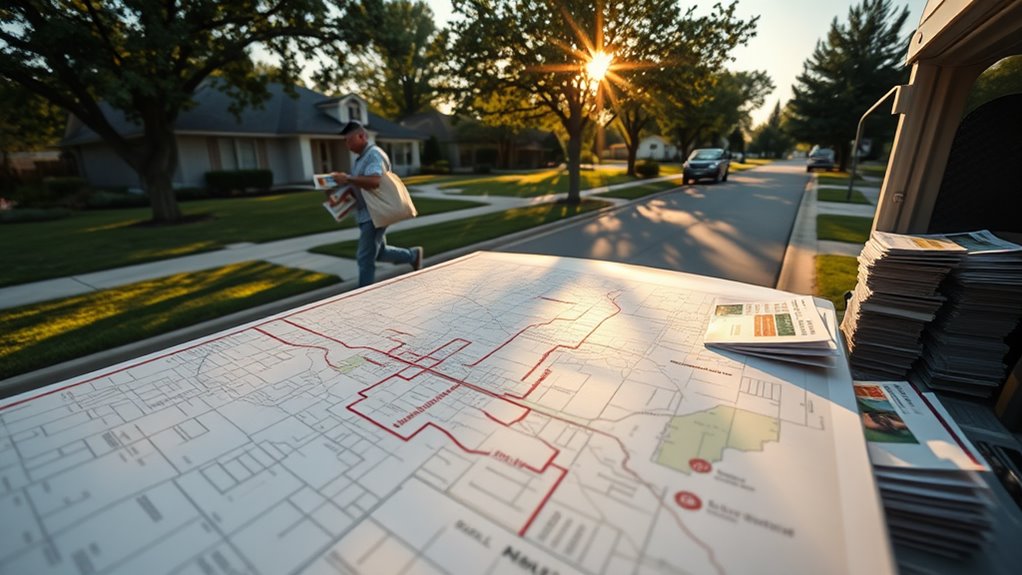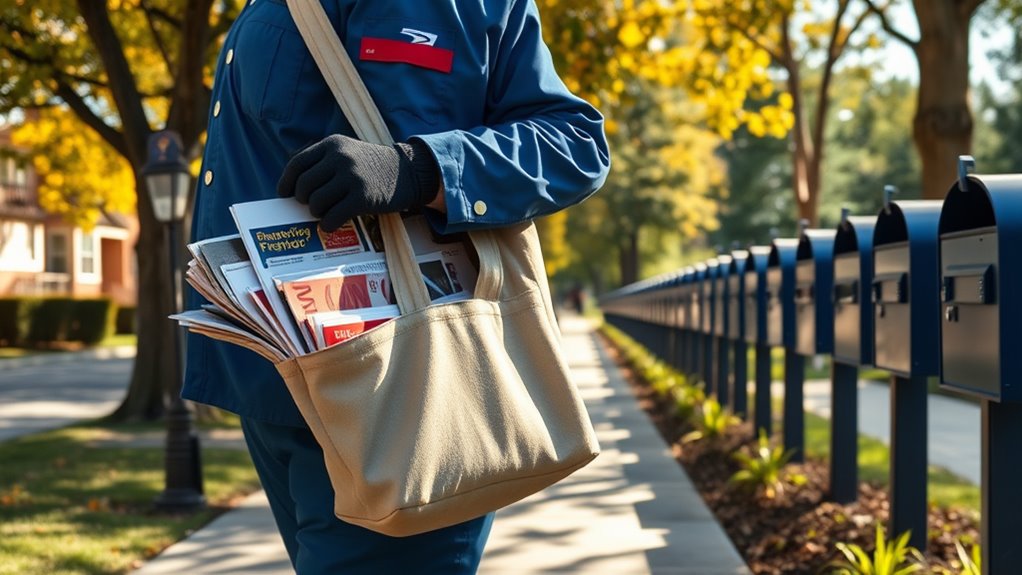The cost to get flyers delivered typically ranges from $60-400 per 1,000 pieces, depending on your chosen method. Door-to-door distribution runs $60-100 per 1,000, while direct mail services cost $250-400 per 1,000. Your location greatly impacts pricing, with urban areas costing $0.06-0.12 per flyer and rural locations reaching $0.15-0.25 per flyer. You'll find substantial discounts for larger quantities, with orders over 25,000 pieces qualifying for 30-40% off standard rates. Flyer size matters too, as legal and oversized formats can increase costs by 15-40%. Understanding the various factors affecting distribution costs can help you maximize your campaign's value and effectiveness.
Key Takeaway
- Door-to-door flyer distribution costs between $60-100 per 1,000 flyers, while direct mail services range from $250-400 per 1,000 pieces.
- Location affects pricing significantly: urban areas cost $0.06-0.12 per flyer, suburban areas $0.10-0.18, and rural locations $0.15-0.25.
- Ordering larger quantities provides substantial discounts, with 25,000+ pieces offering savings of 30-40% off standard rates.
- Standard letter-size flyers (8.5" x 11") are most economical at $0.08-0.15 per piece, with larger sizes costing up to 40% more.
- Seasonal timing impacts costs, with November-December seeing 15-25% increases and January-February offering 10-20% discounts.
Delivery Methods and Their Costs
Several delivery methods exist for distributing flyers, each with distinct cost implications. You'll find that understanding these options helps you make cost-effective choices for your marketing campaign.
Common Delivery Methods:
- Door-to-door distribution: $60-100 per 1,000 flyers
- Direct mail services: $250-400 per 1,000 pieces
- Newspaper inserts: $80-150 per 1,000 copies
- Digital flyer distribution: $30-75 per 1,000 views
When you're choosing a delivery method, you'll need to reflect on factors beyond just the base cost. Door-to-door distribution, while moderately priced, requires careful tracking and verification systems to guarantee completion. Direct mail, though more expensive, offers precise targeting and delivery confirmation.
Additional Cost Considerations:
- Geographic coverage area
- Delivery timeline requirements
- Weather conditions and seasonal factors
- Distribution frequency
- Quality control measures
You can optimize costs by combining methods, such as using digital distribution for urban areas while employing door-to-door services in suburban locations. Many companies find that newspaper inserts work well for reaching older demographics, while digital options better serve younger audiences.
Location Impact on Pricing
Geographic location greatly influences flyer delivery costs, with urban, suburban, and rural areas each presenting unique pricing challenges. You'll find that densely populated urban areas typically offer the most cost-effective rates, ranging from $0.06 to $0.12 per piece due to efficient route optimization.
Location-Based Price Factors:
- Urban Areas
- Higher population density reduces per-piece costs
- Multiple delivery options available
- Typical range: $0.06-$0.12 per flyer
- Suburban Communities
- Moderate density affects pricing
- Mixed residential layouts
- Average costs: $0.10-$0.18 per flyer
- Rural Locations
- Extended travel distances increase costs
- Scattered delivery points
- Price range: $0.15-$0.25 per flyer
Additional Geographic Considerations:
- Regional labor costs impact your final price
- Local competition influences market rates
- Seasonal accessibility affects delivery schedules
- Zoning restrictions may limit distribution methods
You'll need to factor in these location-specific variables when budgeting for your flyer campaign. Consider clustering your distributions in similar geographic areas to maximize cost efficiency and optimize your delivery strategy.
Quantity and Volume Considerations

Order volume plays an essential role in determining your flyer delivery costs, with larger quantities typically resulting in lower per-piece rates. When you're planning your distribution campaign, you'll find that most delivery services operate on a tiered pricing structure that rewards bulk orders.
Typical Volume-Based Price Breaks:
- 1,000-4,999 pieces: Standard rate
- 5,000-9,999 pieces: 10-15% discount
- 10,000-24,999 pieces: 20-25% discount
- 25,000+ pieces: 30-40% discount
Your volume considerations should also account for:
- Minimum order requirements (usually 1,000 pieces)
- Storage capacity if ordering in bulk
- Seasonal demand fluctuations
- Distribution timeline flexibility
To optimize your costs, you'll want to analyze your campaign's reach versus your budget constraints. Consider bundling multiple distributions into a single larger order to maximize discounts. Many providers will let you schedule staged deliveries while still benefiting from bulk pricing, allowing you to maintain fresh inventory and adjust your marketing message as needed.
For maximum cost efficiency, you should plan your quantities at least quarterly, enabling you to negotiate better rates with your distribution partner.
Flyer Size and Weight Factors
The dimensions and weight of your flyers directly impact their delivery costs. When planning your distribution campaign, you'll need to take into account standard size categories and weight thresholds that delivery services typically use for pricing.
Standard Size Categories:
- Letter size (8.5" x 11"): Most economical option, typically $0.08-0.15 per piece
- Legal size (8.5" x 14"): Mid-range pricing, usually 15-20% more than letter size
- Oversized (11" x 17" or larger): Premium rates, often 30-40% higher than standard
Weight Considerations:
- Light (up to 1 oz): Basic rate applies
- Medium (1-2 oz): 25-35% increase in base rate
- Heavy (2+ oz): 50-75% surcharge may apply
To optimize your costs, you'll want to:
- Design within standard size parameters
- Use lightweight paper stock (20-24 lb)
- Take into account folding larger designs to fit smaller categories
- Calculate total weight including inserts or attachments
Many carriers now offer digital weight calculation tools, letting you estimate costs before printing. You'll find that staying within standard dimensions and weight limits can reduce your delivery expenses by 20-30% compared to oversized options.
Target Area Coverage Options

Distribution Models:
- Saturation Coverage: You'll blanket an entire geographic area, reaching 90-95% of households at $0.04-0.07 per piece
- Targeted Coverage: You'll select specific neighborhoods or postal routes, reaching 50-75% of chosen areas at $0.08-0.12 per piece
- Premium Selective: You'll pinpoint exact streets or demographics, reaching 25-40% of ultra-specific locations at $0.15-0.20 per piece
Considerations for Your Choice:
- Market penetration requirements
- Cost per thousand (CPM) goals
- Geographic boundaries
- Demographic matching needs
- Seasonal timing factors
You'll find that each model offers distinct advantages for different business objectives. Saturation works well for retail grand openings, while targeted coverage suits services like lawn care or home improvement. Premium selective delivers best when you're marketing luxury products or high-end services to specific income brackets.
Consider combining models for maximum impact – perhaps using saturation in your core area while targeting premium zones in affluent sectors.
Seasonal Pricing Variations
Building on your distribution model selection, you'll need to account for significant price fluctuations throughout the year. Distribution companies typically adjust their rates based on seasonal demands and operational challenges.
Peak Season Rates (Higher Costs)
- November-December: 15-25% premium due to holiday marketing surge
- April-May: 10-15% increase for spring retail campaigns
- September: 8-12% markup during back-to-school period
Off-Peak Opportunities (Lower Costs)
- January-February: 10-20% discount as marketing activity drops
- July-August: 5-15% reduction due to vacation season
- October: 5-10% savings before holiday rush
Weather Impact Considerations
- Snow conditions may add 5-8% to winter delivery costs
- Rain protection materials increase expenses by 3-5%
- Extreme heat periods might require rush delivery timing
You'll find the best rates by booking your distributions during shoulder seasons—March and June typically offer standard pricing without seasonal markups. To maximize your budget, consider planning your annual campaigns around these predictable fluctuations, potentially saving 15-30% on your total distribution costs through strategic timing.
Cost-Saving Distribution Strategies

While managing your flyer distribution budget requires careful planning, several proven strategies can greatly reduce your costs without compromising reach. You'll find measurable savings through these targeted approaches.
Smart Distribution Strategies:
- Bundle your distributions with other businesses to share carrier costs, potentially reducing expenses by 15-25%
- Focus on high-density neighborhoods where you'll reach more households per distribution route
- Choose shared delivery dates with other advertisers to maximize cost efficiency
Route Optimization:
- Map your distribution areas using postal code targeting to minimize wastage
- Consider walking routes instead of driving routes for dense urban areas
- Utilize route planning software to reduce overlap and maximize efficiency
Quantity and Timing Solutions:
- Order flyers in bulk quantities to secure volume discounts, often 20-30% savings
- Schedule deliveries during off-peak seasons when rates are typically lower
- Combine multiple promotional messages into single deliveries
You'll also benefit from developing relationships with distribution companies, as regular clients often receive preferential pricing and flexible payment terms. Consider testing different distribution zones with smaller quantities before committing to large-scale campaigns.
Conclusion
You'll find that flyer delivery costs vary considerably, but smart planning can maximize your return on investment. Consider the case of Main Street Bakery, which reduced its distribution costs by 40% through targeted neighborhood delivery and seasonal timing. By combining multiple cost-saving strategies, like bulk ordering and shared distribution routes, you can create an efficient campaign that delivers results without breaking your budget.









